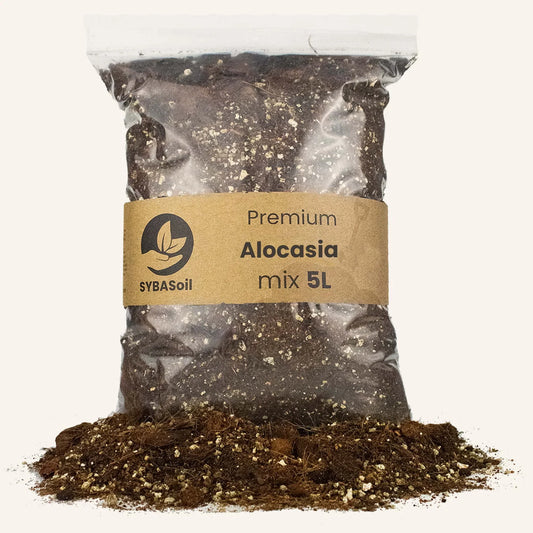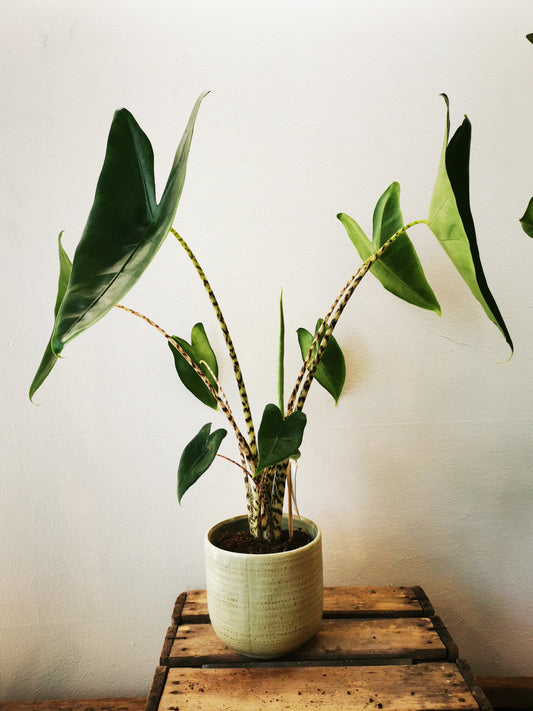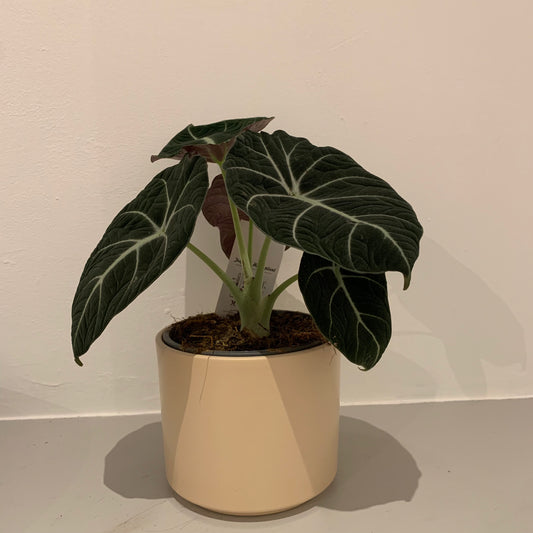
How to care for the Alocasia
Share
Our goal is simple: to enable everyone to keep beautiful plants by teaching them how to care for them. Reading one of our guides is the first step! We proudly present : the big Alocasia Guide. In the guide we tell you where the Alocasia grows, how to care for it, what species there are and what problems you can encounter! Do you like the guide? Then do yourself a favor and subscribe to our newsletter . That way you will receive even more of these guides!
By the way, you can find all our Alocasias here: our Alocasias
The Alocasia General
The Alocasia, also called Elephant Ear , grows in rainforests. They are recognizable by their leaves, which are enormous when they get older. About 79 species of Alocasia are known, that's quite a lot! Fortunately, you only encounter a few species regularly as a houseplant.
The most popular Alocasias are:

- Alocasia Zebrina
- Alocasia Zebrina 'Black Stem'
- Alocasia Macchorizza
- Alocasia Portodora
- Alocasia Amazonica 'Polly'
- Alocasia Wentii
- Alcoasia Cucullata
- Alocasia Frydek
- Alocasia Black Velvet
- Alocasia Silver Dragon
Of course you can get all popular types from us. Don't see the plant you are looking for in the webshop? Send us a message, most likely we can help you!
Where does the Alocasia grow?
Alocasias grow in the rainforests of Indonesia, Malaysia and Thailand. Geographically, that is a warm area with high humidity and lots of sun. What you don't find in the rainforest? Wind, dryness and coolness.
So geography tells us quite a lot about the biology of this plant. Because we now know that we keep Alocasias warm, in high humidity and in good light.
In rainforests there is certainly not always much light, but Alocasia have long stems and really grow towards the light. So do not forget to regularly turn it a quarter turn! Otherwise your Alocasia will completely hang!
In concrete terms, you care for Alocasias as follows:
- Always keep the soil slightly moist
- Mist the plant as much as you can (or place a humidifier nearby)
- Cut off any fallen leaves
- Place it in a good light (but be careful with direct sunlight, it will burn the leaves!)
Common Alocasia problems
In this section we will briefly explain the most common problems with Alocasias. Is your question not listed? Send us a message and we will be happy to help you!

The outer leaves of my Alocasia are turning yellow
That is completely normal! An Alocasia naturally sheds its oldest (outer) leaves. This way it can quickly make room for new leaves, which grow from the inside. You can choose to cut these off immediately (about two centimeters above the ground) or you can let them die off naturally.
As you wish !
The leaves of my Alocasia have a yellow outer edge
A yellow edge on the outside of your leaves can indicate too low humidity . So spray! Especially in new homes, the air is often dry and you have to make an extra effort ! If you don't have the opportunity to spray the leaves regularly, you can also purchase a humidifier.
My Alocasia is hanging completely on its side
An Alocasia grows towards the light, are you turning your plant enough? If your plant really starts to hang to the side, you may need to move it to a place with more light . They love that! You can support it and try to keep it straight, but the Alocasia is not in the right place. What can help is turning it a quarter turn every week, so it grows straight up!
When your plant starts to droop too much, there is a chance that the stem will break. Read here what to do when your plant starts to droop .
The edges of my Alocasia leaves are brown
Brown edges often indicate too much water. Try to water less and give smaller amounts. The leaves that have brown edges will never become beautiful again. You can cut them off, so that it quickly makes new ones or you can leave them until they are replaced. The choice is yours !
My Alocasia is dripping water from its leaves
Aha! The age-old problem. What you are experiencing here is called guttation . A natural process in which the plant loses water through its leaves. Is that harmful? No, not for the plant! But your parquet is probably a little less happy about it, right?
It is difficult to prevent it completely and it occurs in multiple plants. In short, it comes down to the fact that the water level in houseplants fluctuates much more than in nature. This results in higher dips and peaks (and with those peaks you get guttation). In nature, water absorption is much milder and more spread out, which is why it occurs less there.
Want to know more about those drops? Read all about why your plant is dripping here.
The roots of my Alocasia come out of the bottom of the pot.
ALARM! No, honey. That means your Alocasia is growing well. It's almost time to repot it ! But don't do it too soon! Alocasias like to be a bit cramped and don't need a pot that is too big.
How to repot? You can expect content about that soon. But in the meantime, you can find 1001 videos on YouTube that explain it very clearly.
We can give you 1 tip: The Alocasia leaves surprises in its potting soil. Cherish them and take good care of them, and you will soon have 10 more Alocasias!
Need new potting soil for your Alocasia?
Did we miss something in this guide? Or do you still have questions?
Please let us know, so you have an answer to your questions and we can take another step forward!






